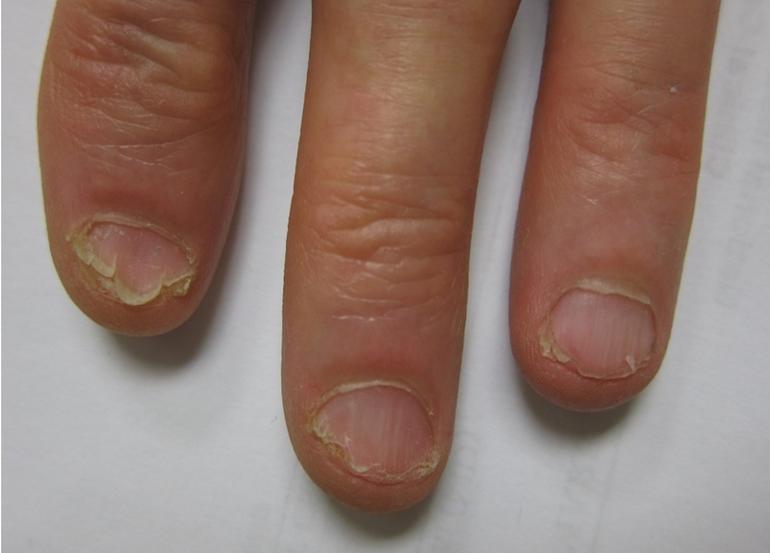A fairly common observation of those taking the BTK inhibitor ibrutinib is that their hair can become curly or straight, or much more annoyingly, their nails can become brittle, so that they crack and become painful. Many have reported good results from taking biotin. (f you do take biotin, it is important to stop taking it a week prior to blood tests for hormone levels and some other blood tests (immunoassays). Standard blood panel counts (CBE/CBC/FBE) aren't affected.) This study confirms those observations and provides some possible reasons for why this happens. (I've also subsequently added a further study below, regarding dermatitis cases with ibrutinib) Ibrutinib was the first approved BTKi and has many more off target effects than later approved BTKi drugs and there's about double the risk of developing atrial fibrillation compared to newer BTKis. healthunlocked.com/cllsuppo... Very few people have mentioned side effects on their nails or hair from these newer BTKis compared to ibrutinib. See the comparison reports referenced later for other advantages of switching, plus a reference on how biotin can cause misleading blood test results for troponin, thyroid hormones, cortisol, follicle -stimulating hormone (FSH) and luteinizing hormone (LH) as a minimum.
From Hair and Nail Changes during Long-Term Therapy with Ibrutinib for Chronic Lymphocytic Leukemia
pmc.ncbi.nlm.nih.gov/articl...
Ibrutinib covalently binds to the cysteine residue at the active site of BTK.1 Since cystines are critical for nail hardness, ibrutinib-induced disruption of the disulfide bonds between cysteine residues could be responsible for increased nail brittleness. Fingernails require 3–6 months to complete a growth cycle. This time interval is consistent with the reported delay of 6.5 months between initiation of ibrutinib therapy and the appearance of nail changes. Toenail abnormalities were reported an average of 9 months after starting therapy, consistent with the slower growth rate of the toenail plate (12–18 months). We consider the nail abnormalities related to ibrutinib because these changes arose on ibrutinib and were not pre-existing, such changes are not part of disease-related complications or associated with standard chemotherapy, and because the timing of appearance of nail changes correlated well with the growth rate of the nail plates. Unfortunately, no pre-treatment photos were available for comparison at the time of the study. Keratinocyte associated proteins in the hair are also rich in sulfur-containing amino acids and form disulfide bonds that contribute to hair structure and tensile strength.12 Hair permanents that contain reducing agents straighten hair through disruption of disulfide bonds.12 Reduced disulfide bonds have free thiols that can migrate and form new disulfide bonds creating more curls as seen with permanent waving agents.12 Ibrutinib disruption of hair disulfide bonds may act in a similar manner to cause alterations in hair strength or texture.
RESULTS (with my emphasis)
The age range of the 66 study participants was 55 to 85 years old, with 43 males and 23 females. 44/66 (67%) participants described new onset fingernail changes after a median time of 6.5 months (95% CI 6–12 months) .15/66 (22.7%) developed brittle toenails after a median of 9 months (95% CI 6–15 months) of ibrutinib therapy (Table 1). Nail changes manifested as mild to moderate onychoschizia and onychorrhexis, corresponding to grade 1 and 2 CTCAE v3.0 adverse events, respectively (Figure 1, Figure 2).10 17/66 (25.7%) patients developed hair changes at a median of 9 months (95% CI 6–12 months) after starting ibrutinib. Most hair changes manifested as straightening and softening of the hair, although 4/17 patients reported increased curliness of hair. Among 5 patients who used oral biotin at 2.5 mg daily, 3 reported significant improvement in their nails. 55% of affected individuals reported a negative impact of hair and nail changes on their quality of life.
Photo from above article showing "Moderate onychorrhexis of the fingernails in a CLL patient after 6 months of ibrutinib therapy."
Added: Ibrutinib-associated pityriasis rosea–like rash
The most common nonhematologic side effects are diarrhea, arthralgia, rash, and brittle nails.2, 3 Three subtypes of ibrutinib-related dermatitis have been reported in the literature: 1) asymptomatic nonpalpable petechial rash, 2) leukocytoclastic vasculitis–like pruritic violaceous palpable purpura, and 3) painless nonpruritic edematous papules with centripetal spread.
pmc.ncbi.nlm.nih.gov/articl...
Some posts on BTKi comparison studies
Efficacy and safety of new‑generation BTKis (primarily acalabrutinib and zanubrutinib) in CLL/SLL: a systematic review and meta‑analysis
healthunlocked.com/cllsuppo...
Largest real world study of acalabrutinib and ibrutinib over 3 years, shows acalabrutinib has improved discontinuation rates
healthunlocked.com/cllsuppo...
What are some common tests that may be affected by biotin?
testing.com/articles/biotin...
Biotin can affect a wide variety of laboratory tests. Examples include tests for:
- Troponin—a test used to help diagnose heart attacks
- Thyroid hormone tests, such as thyroid stimulating hormone (TSH), thyroxine (T4) and triiodothyronine (T3) tests
- Other hormones, such as parathyroid hormone (PTH), cortisol, follicle -stimulating hormone (FSH) and luteinizing hormone (LH)
- Vitamin D levels
Neil
